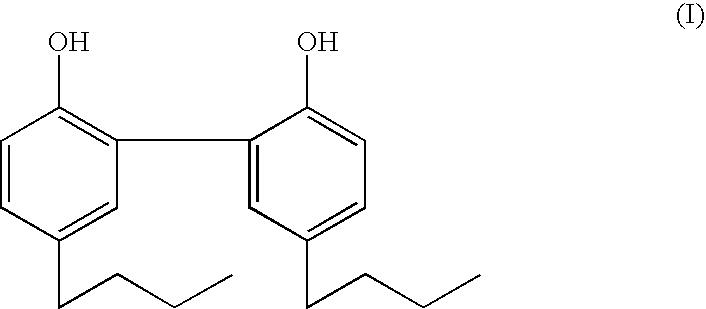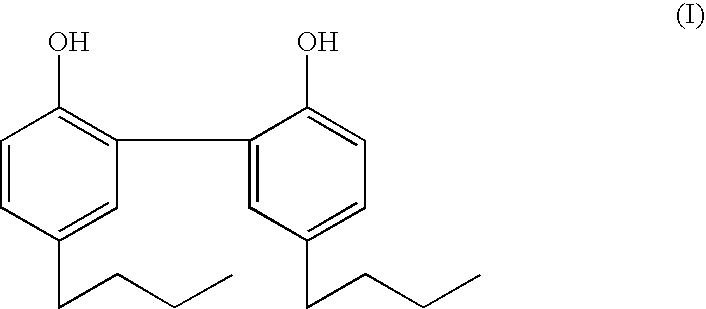Oral compositions containing biphenol antibacterial compounds
a technology of biphenol and composition, applied in the field of oral compositions containing biphenol antibacterial compounds, can solve the problems of reducing the effectiveness of certain cationic antibacterial compounds and certain nonionic antibacterial compounds, and increasing the risk of tooth loss
- Summary
- Abstract
- Description
- Claims
- Application Information
AI Technical Summary
Benefits of technology
Problems solved by technology
Method used
Image
Examples
example 1
[0046] The dipropyl and dibutyl analogs of magnolol are synthesized by Friedel-Crafts acylation of 2,2′-diphenol with propanoyl chloride and butanoyl chloride respectively, followed by Clemmensen reduction to yield 5,5′-propyl-2,2′-dihydroxy-1,1′-biphenyl and 5,5′-dibutyl-2,2′-dihydroxy-1,1′-biphenyl, respectively.
example 2
[0047] MIC50 values against a variety of bacteria are measured for the dipropyl and dibutyl derivatives and compared to those for triclosan. Results are given in Table I. Lower numeric values correspond to more effective antibacterial activity.
TABLE IMIC50 for dipropylMIC50 for dibutylMIC50 forBacteriaderivativederivativetriclosanS. aureus>5007.82S. gordonii>50031.37.8S. mutans>5003.97.8E. corrodens10.5P. gingivalis3.920.5A. actino.>500>5000.125P. intermedia221P. nigresc.7.83.93.9F. nucleatum>500>5001M. catarrhalis7.815.6B. cereus>50031.315.6B. subtilis>5007.82
[0048] As can be seen from Table I against a number of staphylococcus, streptococcus, and bacillus bacteria in the Table, MIC50 of the compound of formula (I) is over an order of magnitude less than that of the dipropyl derivative, and comparable to that of triclosan.
PUM
| Property | Measurement | Unit |
|---|---|---|
| Fraction | aaaaa | aaaaa |
| Percent by mass | aaaaa | aaaaa |
| Weight | aaaaa | aaaaa |
Abstract
Description
Claims
Application Information
 Login to View More
Login to View More - R&D
- Intellectual Property
- Life Sciences
- Materials
- Tech Scout
- Unparalleled Data Quality
- Higher Quality Content
- 60% Fewer Hallucinations
Browse by: Latest US Patents, China's latest patents, Technical Efficacy Thesaurus, Application Domain, Technology Topic, Popular Technical Reports.
© 2025 PatSnap. All rights reserved.Legal|Privacy policy|Modern Slavery Act Transparency Statement|Sitemap|About US| Contact US: help@patsnap.com



